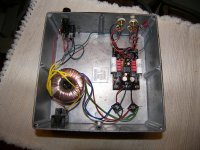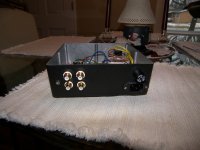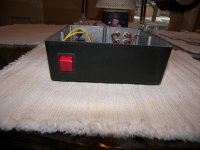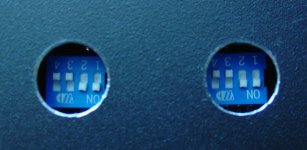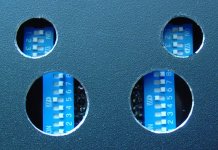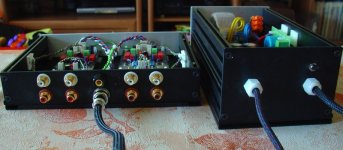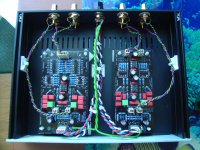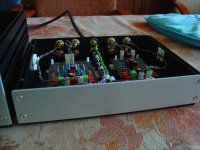The case is definitely too small, which caused a lot of headaches when I wired up all the connections. Still, I am happy with the final result and enjoying my vinyl collection again.
pete
pete
It's one of those things we all seem to have to learn the hard way. 🙂
Rule of thumb: leave at least two inches (5 cm) clearance between the PCB and the chassis connections.
Rule of thumb: leave at least two inches (5 cm) clearance between the PCB and the chassis connections.
alternative view
Rule of thumb: leave less than two inches (50 mm) between the PCB connections and the chassis connections.
Rule of thumb: leave less than two inches (50 mm) between the PCB connections and the chassis connections.
Here's my VSPS build. Overall it went very smoothly, and it worked on the first try😀.
I am getting a slight hum with the volume turned way up. The hum goes away when i disconnect the ground from the power cord. Hum is the same regardless if the power ground is connected to the same terminal as the board ground (as shown in the photo) or if I ground it to the screw for the IEC socket. The hum does not interfere with listening though.
Overall a nice sounding unit.
I am getting a slight hum with the volume turned way up. The hum goes away when i disconnect the ground from the power cord. Hum is the same regardless if the power ground is connected to the same terminal as the board ground (as shown in the photo) or if I ground it to the screw for the IEC socket. The hum does not interfere with listening though.
Overall a nice sounding unit.
Attachments
This hum is caused by a simple ground loop: the signal return (COM) is connected to earth at the VSPS and again somewhere down the chain, in your amplifier for example.
It doesn't occur when you have the power supply and VSPS in a separate chassis, as only the power supply chassis is earthed, and the VSPS COM / VSPS chassis does not connect to it.
The simple solution is disconnect the chassis from the AC earth connection.
A more rigorous modification would be to keep the chassis connected to AC earth for safety, but insert 47 ohm resistor and a small ceramic capacitor in parallel between the GND pad on the board and the chassis ground lug.
I'm not completely sure that will work as advertised, since the turntable gnd wire connects to the chassis and now they will see 47 ohms back to the VSPS COM, but it's easy enough to try.
It doesn't occur when you have the power supply and VSPS in a separate chassis, as only the power supply chassis is earthed, and the VSPS COM / VSPS chassis does not connect to it.
The simple solution is disconnect the chassis from the AC earth connection.
A more rigorous modification would be to keep the chassis connected to AC earth for safety, but insert 47 ohm resistor and a small ceramic capacitor in parallel between the GND pad on the board and the chassis ground lug.
I'm not completely sure that will work as advertised, since the turntable gnd wire connects to the chassis and now they will see 47 ohms back to the VSPS COM, but it's easy enough to try.
Thanks RJM.
I tried adding the resistor/capacitor as suggested, but the hum was replaced by a bit higher pitched, but equally as loud noise. So, I cut the AC ground.
I tried adding the resistor/capacitor as suggested, but the hum was replaced by a bit higher pitched, but equally as loud noise. So, I cut the AC ground.
Separate enclosures (Modus Shop) for phono section and power supply.
There are drills on the bottom of phono section allowing to change settings for MM / MC cartridges.
Opamps: LME49860.
Transformer ( Transformatory toroidalne, audio, separacyjne, trójfazowe - sklep internetowy😛roducent PWPH Lachowski Ksi??yno - Bia?ystok ).
K
There are drills on the bottom of phono section allowing to change settings for MM / MC cartridges.
Opamps: LME49860.
Transformer ( Transformatory toroidalne, audio, separacyjne, trójfazowe - sklep internetowy😛roducent PWPH Lachowski Ksi??yno - Bia?ystok ).
K
Attachments
Hi,
the OP27 is not easy to find, is it worth searching for them or is there a nice substitution out there?
KR Hauke
the OP27 is not easy to find, is it worth searching for them or is there a nice substitution out there?
KR Hauke
Look for the OPA27, it's the same as the OP27 and quite common.
Hi,
will the OPA37 will do the job as well?
KR Hauke
No, the OPA37 is unstable in the phonoclone circuit as a result of the larger gain-bandwidth product (55Mhz vs 8Mhz).
No, the OPA37 is unstable in the phonoclone circuit as a result of the larger gain-bandwidth product (55Mhz vs 8Mhz).
Hi,
i would like to use the OPA37 in the VSPS300i.
KR Hauke
My comment applies equally well to the VSPS as apart from the input stage they are almost the same circuit.
/R
/R
op27 which one
There are different op27 to find with different suffixes like op27EZ, op27EP, op27GP the difference seems to be the slew rate and bandwith which ones are to choose.
Thank you for any help
Chris
There are different op27 to find with different suffixes like op27EZ, op27EP, op27GP the difference seems to be the slew rate and bandwith which ones are to choose.
Thank you for any help
Chris
Last edited:
HI
Just to check is there any VSPS builder that using a Silver mica for C1 and C2 position as suggested by Richard. He said mica is a step better that the stock Wima FKP?
Just to check is there any VSPS builder that using a Silver mica for C1 and C2 position as suggested by Richard. He said mica is a step better that the stock Wima FKP?
I think most of the VSPS 300's were built with silver mica, while all the VSPS Kits ended up with the stock wimas.
I think most of the VSPS 300's were built with silver mica, while all the VSPS Kits ended up with the stock wimas.
Right...but need to know how much improvement can be gain from stock wima to silver mica...?
I see. Well, the improvement is 16.5%. So now you know. 🙂
[Mica sound cleaner than mica.]
Man...that's accurate....how do you calculate Richard.....?😛
BTW 1000pF Mica arrived yesterday. Will be putting that. I'm curious all of them specially the leads is magnetic. Won't this a no no for signal lines...?
- Home
- Source & Line
- Analogue Source
- The Phonoclone and VSPS PCB Help Desk
